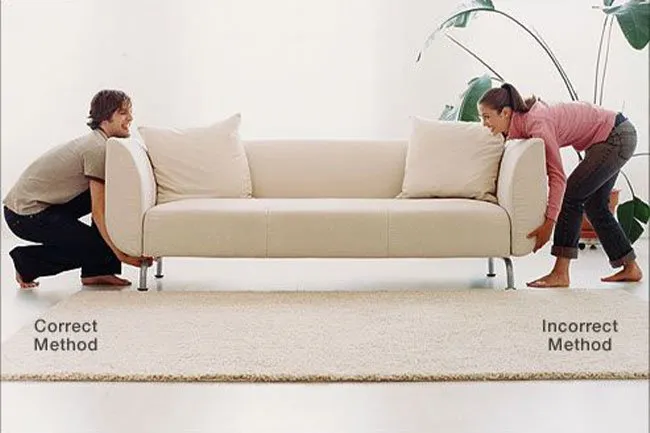Start the Day With Gentle Activity

Slow, gentle activity in the morning can help wake up tired muscles and stiff joints. Just take it easy on your spine, says Raj Rao, MD, professor of Orthopaedic Surgery and Neurosurgery at the Medical College of Wisconsin. Deep, relaxed breathing when you wake up may also be helpful. But certain moves aren't recommended if you have back pain -- ask your health care provider what's best for you.
Wear Comfortable Shoes

To help keep your back feeling healthy, choose comfortable, well-cushioned shoes. Although low-heeled shoes are best for everyday wear, heels aren't necessarily a no-no. Choose a pair with a cushioned sole, says Rao. Cushioned soles reduce the impact when you're walking on hard surfaces. This helps protect your back, hips, and knees.
Start Exercise Gradually

Exercise is a great way to keep your back healthy. But if you've been inactive for a while, start slowly. Begin with a low-impact exercise such as walking, stationary biking, or swimming for about 30 minutes a day. Adding gentle stretching or yoga may also help your muscles. Ask your doctor what types of exercise are best for you.
Sit Comfortably

If your job requires you to sit for long periods, make sure your chair has a straight back, an adjustable seat, and armrests. Some people prefer more lumbar support than others, says Rao. If you need extra support, place a rolled towel behind the lower part of your back. Resting your feet on a low stool can also help ease back pain when sitting.
Work Ergonomically

If you spend most of your day at a computer, your work station can affect your back's health. You shouldn't have to lean forward to reach your keyboard or see your monitor. Instead, move them closer, so you can keep your elbows at your side as you work, says Rao. You should also adjust your computer screen so it is just at or below eye level.
Take a Break

If you do a lot of sitting or standing during the day, take a break every so often to move around. Just a short walk around the house or office can help relieve tight joints and muscles. You can also try doing some gentle stretches. When a break isn't possible, make sure to change your position occasionally.
Practice Good Phone Posture

Your shoulder may make a great phone rest when you need to multitask in a pinch. But this posture is a common cause of neck pain and can also contribute to poor alignment in the back. When you need to make a hands-free call, use a shoulder support, headset, or the speaker function on your phone instead.
Stand Smart

Standing for long periods can be stressful on your lower back. If you have to stand for work, try placing one foot on a stool or other low object. Then change feet every so often. This will help take the pressure off your lower back. Wearing cushioned shoes or standing on a thick rubber mat can also help relieve pressure when you have to stand for long hours, says Rao.
Learn to Lift Properly

Lifting children and other heavy objects is a common source of back pain. Follow these tips to protect your back:
- Get close to the object you're lifting. Keep your elbows as close to your trunk as possible, trying not to reach your arms away from your body, says Rao.
- Bend your knees and lift with your legs and stomach muscles.
- Don't twist as you lift.
Ask About Stairs

Taking the stairs is often suggested as a way to fit more exercise into your day. But walking up stairs may not be the best exercise for some people with low back pain, especially older adults and those with knee problems. So before you head for the stairwell, ask your doctor whether taking the stairs is the right option for you.
Adjust Your Driving Position

Driving long distances can put a strain on your low back. Follow these tips to help keep your back feeling good, even on the longest trips.
- Move your seat forward so you don't have to bend to reach the steering wheel.
- Put a rolled towel, small pillow, or other lumbar support behind your lower back.
- Take a break every hour on long trips to get out of the car and walk around.
Know What Exercises to Avoid

If you've had a back injury or are dealing with certain back conditions, there may be some exercises that you shouldn't do at all until your doctor gives approval. These may include contact sports, racket sports, golf, weight lifting, dancing, jogging, and sit-ups. Your doctor may also advise against doing leg lifts while lying on your stomach. Ask your doctor about any other specific exercises you should avoid.
Push With Care

Activities that require pushing, such as vacuuming, using a stroller, and mowing the lawn can strain your lower back. Again, keep your elbows as close to your trunk as possible. Don't push with straight arms, Rao recommends. Choosing a lightweight stroller or vacuum can also help. If the activity still feels like too much, try doing a little at a time.
Choose the Best Sleep Position

Sleeping on your side is the most common sleeping position. Placing a small pillow between your knees helps keep the back in a good position. If you must sleep on your back, try using a pillow under your knees. Avoid sleeping on your stomach, as this can make back pain worse.
Keep Your Weight Down

Carrying extra weight on your body means more work for your lower back muscles. This is especially true if the extra pounds are around your waist. The heavier you are, the more impact there is on your back with each step. Losing weight can also help protect the muscles and joints in your knees and hips.
Back Pain: Everyday Activities with Low Back Pain
This tool does not provide medical advice. See additional information: 
© 1996-2024 WebMD, LLC. All rights reserved.
